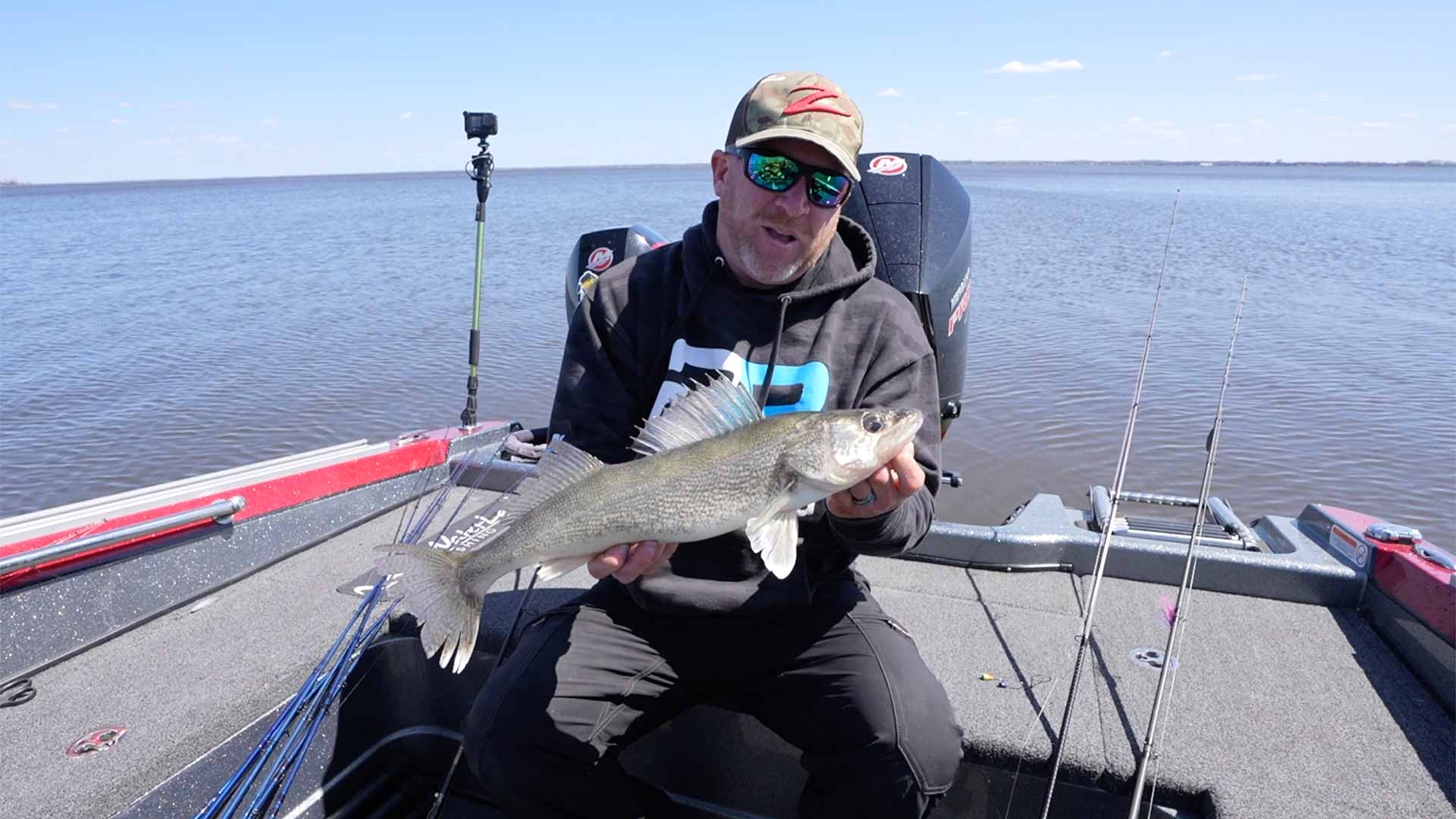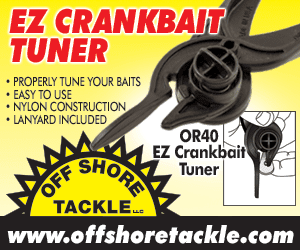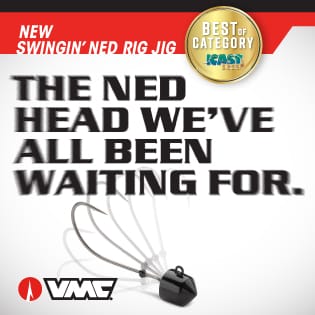Leadcore Trolling for Summer Walleyes
The whole key to catching walleyes in open water is replication, and that’s what leadcore trolling does so well. It enables you to put the bait at the exact same depth it was last time you caught a fish.
We’ve been experimenting with a a wide variety of baits, but so far we’ve caught fish on the Rapala Scatter Rap Husky Jerk, a new bait with a smaller minnow profile, and Michael‘s caught a few fish with a small perch colored Shad Dancer. If the fish start to show a bait preference, we will move in that direction with our offerings. When you’re trolling, it’s interesting how selective at times the fish can be based on color, the size of bait, and vibration. That’s why so many different walleye trollers actually have so many different baits. It’s amazing – they have boxes and boxes.
The last two fish we caught came from about 170 feet back with leadcourse. Today, we’re using Sufix 832 12-pound test leadcore line. This line has color indicators every thirty feet, which equals about five or six feet in trolling depth per color. This means you can gauge things a couple of different ways. You can either use a line counter reel to approximate your depth, or you can use colors on the line if you don’t have a line counter.
The whole key with this open water leadcore trolling, as we were saying, is the replication of a couple of different things: the speed of the bait and it’s depth in the water column. These fish move up and down based on their activity level.
Right now, we’re catching a lot of the fish with four colors out, and we’re running a Scatter Rap as well as a Shad Dancer. The fish we are catching are really tight to the bottom, but you might come out here on a different day and these fish might raise up off the bottom. We might need to position the baits 25 feet down or maybe as high as 15 feet down depending on where the fish are positioned.
It’s sort of fun and there’s a real art to being successful at a trolling. This is why so many of the tournament walleye fishermen are very, very good at this technique: it catches really big fish throughout a good portion of the year at different points in time. It is amazing how effective leadcore trolling can be especially when you have small baits and you fine-tune your depth and speed.
Taking Advantage of Feeding Periods
When the water temperature is in the mid to upper 70s, it’s important to take advantage of the major feeding periods early in the morning and in the evening. During the day, when the fish are less active, you should focus on using reaction-style baits. Look for long break lines and expansive flats on the west side of the lake. This is the perfect time to start trolling crankbaits like number five and number seven shad wraps, flicker shads, and other similar baits that imitate the natural forage of walleye.
Finding the Right Depth
When trolling for walleye, it’s crucial to find the right depth where the fish are actively feeding. This can vary depending on the time of day, water temperature, and the presence of baitfish. In this video, the anglers mentioned focusing around the thermocline, which was about 70 feet deep. By targeting just above and below this temperature break, they were able to locate the phytoplankton, zooplankton, and alewives that the walleye were feeding on.
Using the Right Trolling Speed
The speed at which you troll can greatly affect your success in catching walleye. In this video, the anglers mentioned trolling at speeds ranging from 2.1 to 2.7 mph. This speed allowed them to effectively present their baits to the walleye and trigger a strike. It’s important to experiment with different speeds to find what works best on any given day.
Choosing the Right Baits
When it comes to trolling for walleye, the choice of bait is crucial. In this video, the anglers mentioned using a variety of baits, including the Bandit Generator, the Rapala Down Deep Husky Jerk, the Rapala Jointed Shad Rap, and the Salmo Hornet. These baits were chosen based on their ability to imitate the natural forage of walleye and their effectiveness in triggering strikes. It’s important to have a variety of baits in your tackle box to adapt to changing conditions and preferences of the fish.
Using Spinner Rigs
Spinner rigs are another effective bait option for trolling walleye. In this video, the anglers mentioned using Northland Tackle’s Baitfish Spinner and Baitfish Spinner Floating Model. These spinner rigs feature unique fish designs on the blades and are designed to attract walleye. They also mentioned that the floating model is great for keeping the rig off the bottom when using crawlers or leeches. Spinner rigs can be a great choice when the walleye are feeding on smaller baitfish or when you want to add some extra flash and vibration to your presentation.
Selecting the Right Rod and Reel Combo
Having the right rod and reel combo is essential for successful trolling. In this video, the anglers mentioned the Diwa C Line reel and the Okuma trolling combo. The Diwa C Line reel features a line counter, a clicker switch, and a great drag system, making it ideal for trolling. The Okuma trolling combo is specifically designed for trolling and features a balanced rod and reel that provide the right action and sensitivity for detecting strikes and fighting fish.
Protecting Your Equipment
When trolling, it’s important to protect your valuable equipment, such as your sonar GPS and graphs. In this video, the anglers mentioned using the Balls Out Mounts to secure their equipment. These mounts are made from airplane-grade aluminum and provide a strong and sturdy hold. They are a great investment for protecting your equipment from the impact of waves and ensuring that they stay in place during rough conditions.
Using the Right Blade Color
When trolling for walleye, the choice of blade color can make a difference in your success. In this video, the anglers mentioned using rainbow or silver-colored blades, which worked better for them than the traditional bug hatch colors. It’s important to experiment with different blade colors to find what the walleye are responding to on any given day.
Adjusting Your Trolling Depth
To effectively troll for walleye, it’s important to adjust your trolling depth to match the depth at which the fish are feeding. In this video, the anglers mentioned using bottom bouncers and letting them settle in until they made contact with the bottom. This allowed them to present their baits at the right depth and increase their chances of getting a strike. It’s important to pay attention to the bottom structure and make adjustments as needed to keep your bait in the strike zone.
The Importance of Having a Variety of Spinner Blades
Having a variety of spinner blades in your tackle box is essential for trolling success. In this video, the anglers mentioned using the Wingnut blade, which has a kicking searching action that proved to be effective on that day. However, they also emphasized the importance of having a ton of spinner blades with you and being able to change them out. Different blades can produce different actions and vibrations, so it’s important to experiment and find what works best for the walleye on any given day.
The Technique of the Week: Identifying Fish and Choosing the Right Bait
In this video, the anglers discussed the importance of identifying fish and choosing the right bait. They mentioned that the type of structure you’re fishing and the presence of baitfish can give you clues about what the walleye are feeding on. In this case, they were fishing on a flat area before a bug hatch, and the walleye were feeding on larva and shiner minnows. They found that imitating the shiner minnows with rainbow or silver-colored blades worked better than using bug hatch colors. It’s important to pay attention to the conditions and adapt your bait selection accordingly.










